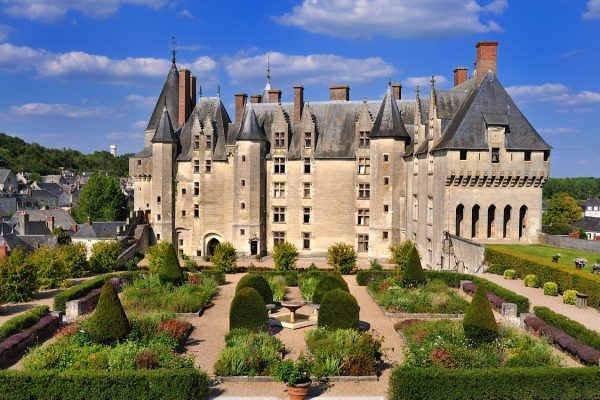Tourism in Loire Valley

The Loire Valley has been listed as a UNESCO World Heritage Site since November 2000 for its “exceptional cultural landscape” which extends over nearly 300 km, from Sully-sur-Loire (in Loiret) to Chalonnes-sur-Loire (in Maine -et-Loire). Located in the south of this classified territory, in the Véron (this “peninsula” near Chinon between the rivers Loire and Vienne), La Pénesais gives you access to a wealth of multiple heritages within a radius of 30 km:
The historical heritage
- Chinon (4 km), the city which was twice capital: capital of the kingdom of England under Henry II Plantagenêt, and capital of the kingdom of France under Charles VII.
- Its royal fortress which saw Philippe Auguste, Joan of Arc, Richard Coeur de Lion, Eleanor of Aquitaine, but also the great Templar masters
- Rigny-Ussé (12 Km): the castle of Sleeping Beauty since it is there that Charles Perrault wrote his famous tale.
- Le Rivau (18 Km): Formerly the cradle of the royal stallions, the castle now has a magnificent garden redesigned like a fairy tale, and classified as a “remarkable garden”.
- Azay-Le-Rideau (23 Km): castle unfinished by its builder, it is a jewel on the banks of the river Indre.
- Saumur (25 Km): the “castle of love” of the good King René of Anjou. Also worth seeing: Le Cadre Noir, a unique and world-renowned (military) school of equestrian art.
- Langeais (28 Km): “the ancestor” of the Loire castles, with over 1000 years of history
- Villandry (35 km): the last of the great castles of the Loire Valley and its magnificent French gardens.
- Candé (40 Km): the “Art Deco” castle made famous by Edward VIII, Duke of Windsor who abdicated from his throne of England to marry Wallis Simpson here in 1939.
- and also the Château de Sonnay (12 km away), famous since the filming of the series Emily in Paris!
…and many more, to be discovered by exploring the small surrounding roads.
The cultural heritage
- Fontevraud Abbey (15 Km): the largest abbey in Europe, last home of the Plantagenet dynasty: Henri II, his wife Eleanor of Aquitaine and his son Richard Coeur de Lion. It also houses a superb Museum of Modern Art and his Cligman collection.
- The Château de l’Islette (29 km): theater of the artistic and romantic adventures of the sculptors Auguste Rodin and Camille Claudel.
- La Deviniére (8 Km): the birthplace of Rabelais, which now houses a museum dedicated to this great humanist deeply rooted in this territory so-called “La Rabelaisie”. Take advantage of your visit to La Pénesais to (re-)read its famous “Pantagruel” or “Gargantua” and visit the surrounding places that inspired François Rabelais 5 centuries ago.
- The Balsac Museum, in Saché (30 Km), to enter into the intimacy of this monument of French literature
- Montsoreau and Candes-Saint-Martin (10 km): 2 twin villages at the confluence of the rivers Loire and Vienne, listed in the directory of the most beautiful villages in France. The largest flea market (antiques and bric-a-brac) in Indre & Loire is held there every 2nd Sunday of the month on the banks of the river Loire.
- Le Musée du Véron (4 Km): Classified as a “museum of France”, this museum presents an “Art Nature Culture” tour and exhibits very beautiful works by “local” artists such as Rodin, Max Ernst and Calder..
- The Loire-Anjou-Touraine Regional Natural Park, which covers 116 municipalities in Indre&Loire and Maine&Loire. Its “Maison du Parc” is located in its center, in Montsoreau (15 Km).
The gastronomic and oenological heritage
Come and taste the goat cheeses of Sainte-Maure, the winegrower’s tart and the “women’s tongues” (Chinon), the pears “tapées” (Rivarennes), the “rillons and rillettes of Touraine”, and a thousand other local specialities…
…and of course the wines of Chinon:
We talk about Chinon wines, in the plurial, because the AOC Chinon (certification of origin) covers 3 different terroirs: alluvial terraces, clay plateau with flint, mounds and limestone hillsides. Each of these terroirs gives a different personality to the wine produced on these soils.
The wines of Chinon represent the largest red AOC appellation in Touraine, with 15 million bottles/year, broken down into 86% red, 12% rosé, 2% white.
The red Chinon grape varieties are mostly Cabernet Franc (known as “Cabernet Breton”) + 10% Cabernet Sauvignon. The white Chinon are mono-varietal, 100% Chenin (known as “Pineau de Loire”).
Chinon wines are the product of the labor and experience of 173 producers and 60 merchants, on 2350 hectares, 25% of which are organic.
The wines of Chinon have their brotherhood: “La Confrérie des Entonneurs de Rabelais”, the 2nd largest brotherhood in France after “Le Tastevin” of Burgundy. It holds 4 meetings (called “chapters”) a year, in the hall of the Caves Painctes de Chinon.
We will be happy to give you some addresses of passionate local winegrowers, or to direct you to “La maison des vins du Véron”, in Beaumont-en-Véron, to find out all about the wines of the Chinon region.
